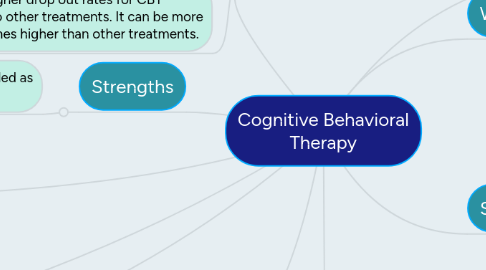Cognitive Behavioral Therapy
af Cameron Adriaan


1. Otto and Winsniewski (2012) conducted in the UK found that for people who do not respond well to drug treatment, CBT is an effective add-on treatment, leading to an improvement in symptoms for 55% of the CBT group compared to 31% receiving the regular treatment alone.
2. Butler & Beck [2001] did a meta-analysis of 325 studies across a range of disorders and therapies. The success of therapies is calculated using relapse rates ans a statistical formula called effect size. Anything below 0.5 is not effective, 0.5-0.8 is medium, and anything above 0.8 is really good. Beck’s cognitive therapy scored 0.9 for both adult and adolescent depression, and scored highly for many other disorders such as bulimia and generalised anxiety disorder. They also found relapse rates to be 29.5% for CBT, and 60% for antidepressants.
3. Teaches you strategies that can be used in everyday life, even when treatment is finished.
3.1. For example thought records. Thought records tend to help change beliefs on a logical level, therefore improving negative thoughts.
4. Supporting evidence
4.1. It’s now the dominating force in clinical psychology. This is the therapy of choice, suggesting it works and is popular amongst the therapists who are afterall the experts!
5. Strengths
5.1. Does not carry side effects, so it s regarded as more ethical.
6. Weakness
6.1. CBT essentially blames the person for their disorder because it is their thoughts that cause the disorder; this could have ethical implications for how the person feels about themselves.
6.2. There are higher drop out rates for CBT compared to other treatments. It can be more than five-times higher than other treatments.
7. Cognitive behavioral therapy (CBT) is a short-term, goal-oriented psychotherapy treatment that takes a hands-on, practical approach to problem-solving.
8. What is it?
8.1. Its goal is to change patterns of thinking or behavior that are behind people’s difficulties, and so change the way they feel.
9. Sessions
9.1. A CBT session tends to last about 50 minutes, and there would usually be around 6 sessions. A review would then take place.
9.2. In each session, an agenda is set with the client so that they decide which issues will be raised.
9.3. The first session involves contracting and setting the scene about what is expected.
9.3.1. For example, ethical issues such as confidentiality and privacy have to be discussed, as well as other issues such as the client having to do homework to help themselves to overcome any faulty thinking.
